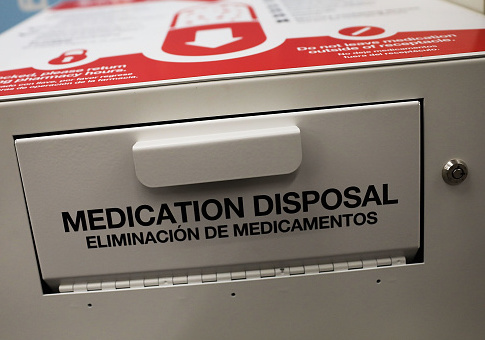People looking to dispose of their unused prescription drugs will soon be able to just ask Google, the firm announced Thursday.
As part of a collaboration with the Drug Enforcement Agency and the Department of Health and Human Services, Google will allow users searching for related terms to identify one of more than 3,500 prescription drug disposal locations near them. Drug disposal sites will include public ones administered by state governments and local law enforcement, and private ones through corporate partners CVS and Walgreens.
The program will initially roll out in seven states: Alabama, Arizona, Colorado, Iowa, Massachusetts, Michigan, and Pennsylvania. Massachusetts and Pennsylvania have struggled in particular with opioid overdoses. Alabama remains the state with the highest number of opioid prescriptions per capita.
Prescription-drug take back is a key component of the nation's drug control strategy. Despite substantial reductions in recent years, there are still a huge number of opioid prescriptions in the United States—more than 191 million were issued in 2017 alone, likely meaning billions of pills available.
People who choose to abuse prescription pain relievers generally obtain their drugs in one of two ways, according to the National Survey on Drug Use and Health. About 36 percent get their drugs from one or more doctors directly, while the majority—53 percent—either stole, bought, or were gifted the drugs from a friend or relative. In other words, of those billions of pills, many are likely being taken out of medicine cabinets, knowingly and unknowingly, and abused in dangerous frequency or excess.
The goal of drug take back, then, is to remove unused prescription drugs from the nation's medicine cabinets, making sure pills that patients did not need do not end up misused or abused. For the past nine years, the DEA has twice annually run "drug take back day," a nationwide event meant to encourage Americans to drop off their pills at local police stations or pharmacies, where they can be safely disposed of.
During last year's drug take back days, the DEA partnered with Google to make users aware of where exactly they could drop off their drugs. The result was record hauls, with the DEA and local partners collecting some 1.85 million pounds of prescription drugs.
The technology used during 2018's drug take back days was born of a 2017 "code-a-thon," hosted by HHS and previously covered by the Free Beacon. As of Thursday, that technology will be available year-round to users in the seven roll-out states. Users searching terms like "drug drop off near me" or "medication disposal near me" will be directed to pharmacies, hospitals, or government buildings where they can safely and legally dispose of their prescription drugs.
"By bringing opioid disposal site information to Google Maps, Americans are only a search away from helping to address the opioid crisis," said Ed Simcox, chief technology officer of HHS. "This type of consumer empowerment—providing easily accessible data—is the kind of innovation needed to improve health care."
Google and the DEA are working to expand the program nationwide, adding additional location data as it becomes available.
